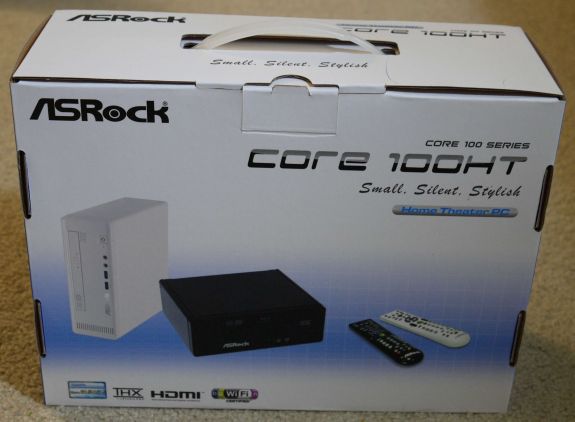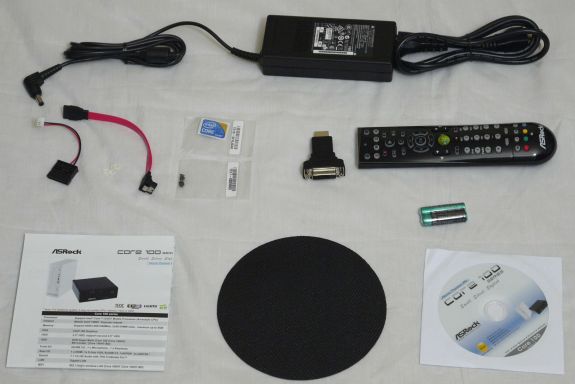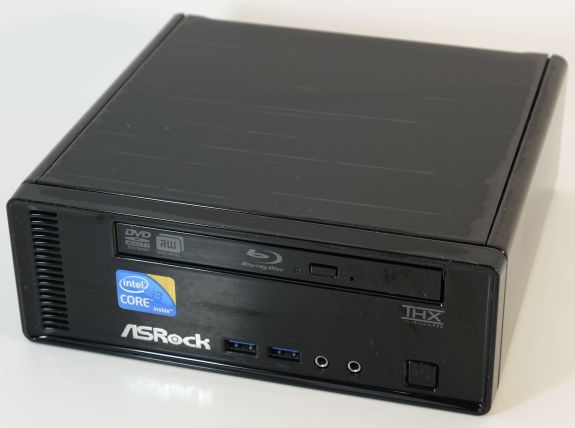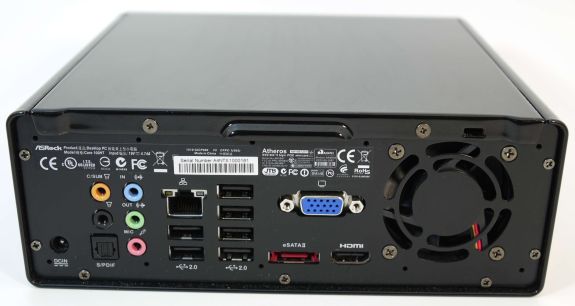ASRock Core 100HT-BD : Bringing HTPCs to the Mainstream Market [UPDATED : Noise Issue]
by Ganesh T S on July 19, 2010 9:34 PM EST- Posted in
- Home Theater
- Arrandale
- ASRock
- Media Streamer
- Core i3
- HTPC
The Core 100 HT-BD comes in a small package, and at first you wonder how such a powerful unit could come in such a small size.
Apart from the main unit, the package also bundles the following:
1. 90W AC / DC Adapter
2. SATA and power cables, as well as mounting screws for an optional second 2.5" hard disk
3. HDMI to DVI adapter
4. MCE remote and batteries.
5. Manual with instructions for disassembling and mounting the optional disk drive
6. Anti-slip pad for the base of the unit
7. CD with drivers and ASRock utilities
The appearance and dimensions of the unit are very similar to that of the ION 330-HT that was reviewed last August. The build quality of the chassis is top notch, and the unit will have no problem in blending with the A/V equipment of most consumers. However, the abrupt edges of the unit will not sit well with those interested more in the aesthetics and appearance rather than the internal capabilities of the unit. In the next iteration of the product, ASRock will probably work on the industrial design a bit more. Replacing the slimline Blu-Ray drive with a slot-loading type drive would also improve the appearance. These types of changes would enable them to cater to the segment of consumers who go more by the looks also.
We had mentioned in the ION 330 review about the absence of ports on the front panel being a bit strange, and ASRock has duly taken note, putting two USB 3.0 ports on the front panel. In addition, we also have headphone and microphone jacks in front. A set of vents on the left of the front panel helps in cooling the unit by maintaining air circulation. The slimline Blu-Ray drive is the same as those which make an appearance in various notebooks. The cost of such drives has come down drastically in the last 1 year, and we don't expect this component to add on too much cost over the DVD drive only version. Notably absent in the ION 330, but making an appearance in this unit is the THX logo above the power button to the right of the front panel.
ASRock uses the two sides of the unit as antennae for the Atheros WiFi module. Moving on to the rear of the unit, we find the adapter power input, followed by the audio ports. Analog audio output can be connected directly to the speakers, or the optical SPDIF output can be used to connect to older A/V receivers. Following this is the Gigabit Ethernet port, and 6 USB 2.0 slots. Further to the right, we have the VGA output (we really needed a DVI here), beneath which one gets the eSATA slot and HDMI output port. Wrapping up this panel is the ventilation fan. Our only gripe with the back panel is the placement of the eSATA port, which makes it difficult to connect external hard disks, particularly when the VGA port is being used.
Just like a notebook, this unit also supports simultaneous display on two monitors. Testing was done mostly with the HDMI output connected to a Toshiba REGZA 37" 1080p TV through an Onkyo TX-SR 606, and the VGA port connected to a old Dell monitor running at 1280x1024. It must be noted that the HDMI port on the unit is only 1.3a. This makes it impossible for the unit to drive monitors with resolutions higher than 1920x1080. Even extremely affordable 2048x1152 monitors such as this one from Dell are left unsupported at their maximum resolutions. However, we expect that this will not be a concern to buyers, since the unit will probably end up getting connected to a 1080p TV in most scenarios.
The Core 100 HT-BD ships with no OS installed. For the purpose of this review, we loaded up a copy of Windows 7 Ultimate x64. It is also possible to install Ubuntu or any other Linux distribution and still be able to take advantage of most of the HTPC functions of the system. Our analysis in the rest of the article, however, is completely from the Windows 7 standpoint.
Starting with this piece, all our media streamer and HTPC reviews will carry a table summarizing the data and A/V connectivity options for the unit from a home theater perspective. We will conclude this section with the same.
| Option | Status |
|---|---|
| HDMI | Yes [v1.3a] |
| Component | No |
| Composite | No |
| VGA | Yes |
| SPDIF | Yes [Optical] |
| Stereo | Yes |
| Option | Status |
|---|---|
| Optical Disk Drive | Yes [Blu-Ray] |
| USB | Yes [6 x v2.0, 2 x v3.0] |
| eSATA | Yes |
| LAN | Yes [ 1000 Mbps GbE ] |
| Internal HDD | Yes [ 500 GB ] |
| WiFi | Yes [ 300 Mbps 802.11n ] |
| Card Reader | No |














107 Comments
View All Comments
ck_mb - Tuesday, July 20, 2010 - link
Does the video card pass WMC cablecard test? I have a AMD 780G that doesn't, since this motherboard doesn't have any expanision slot it would be worthless as a dvr using cablecards.ganeshts - Wednesday, July 21, 2010 - link
Yes, the system passes the Digital Cable Advisor test without any issues.schoenbe - Wednesday, July 21, 2010 - link
An HTPC without a TV tuner is not an HTPC. It is a media player.In the case of the Core-100HT-BD reviewed here, a powerful media player. But you still can't watch TV with it. You cannot record TV with it. Not even a single channel, let alone several channels simultaneously. Anandtech should not recommend this unit as an HTPC. Besides, $700 for a media player? For playing back BD discs and media files? Not sure who wants to pay this much for an incomplete feature set.
DigitalFreak - Wednesday, July 21, 2010 - link
If you don't like it, don't buy it. Is someone standing there with a gun to your head?EnzoFX - Wednesday, July 21, 2010 - link
In my experience, USB tuners are the easiest for people to work with. This unit is targeted at people who probably wouldn't be willing to open up a computer case and install an internal tuner IMO. Personally, I think the best tuner is the HDHomeRun, which is a network based tuner, so this ASRock unit definitely delivers in every regard.schoenbe - Thursday, July 22, 2010 - link
"... this ASRock unit definitely delivers in every regard." Really? Even if you have to go out and buy a TV Tuner and make it work? This product definitely doesn't deliver the complete package.Ipatinga - Wednesday, July 21, 2010 - link
In the article, there is a part where it says "... One must also take into consideration the cost of the Atheros AR9287, which can be bought for around US $15 online..."Where can I find Mini PCI Express 1x Wireless Adapters (Half Height or not) like this Atheros AR9287 this cheap ($15)?
Thanks :)
ganeshts - Thursday, July 22, 2010 - link
This is the listing I was referring to:http://cgi.ebay.com/Atheros-Dual-Band-AR9287-Wirel...
cjs150 - Thursday, July 22, 2010 - link
Ganeshts: I think you and I have different definitions of noisy. Lets take a simple and real life example.I am listening to classical music - obviously a quiet section, the 1812 overture can be heard over a jet engine!
At same time I have firefox up and running (couple of tabs one of which is of course Anandtech but the other is a chess site I use)
I am also running a chess analysis program, fritz, which will take whatever CPU capacity you through at it
Pretty obviously under this scenario the IGP is not fully loaded but the CPU could be running close to capacity.
My Sofa is 6ft away.
If I can hear the ASRock then it is too loud. By comparison my main work rig (admittedly water cooled), I cannot hear other than possible a very slight noise of air movement.
We all know that manufacturer claims of noise levels are typically overstated (expecially by fan manufacturers) but to be suitable for me the noise (close to the machine) has to be sub 30db or even sub 25db. It is not difficult but does limit the cooling to a slow running 140+mm fan.
Mind you the loudest thing in the living room (apart from my daughter) has to be the cable set up box - but only when it starts up from sleep, some really bad design I think there
ganeshts - Thursday, July 22, 2010 - link
cjs150,Noise is a very subjective issue. What might be noisy to me might be OK to you, or vice versa. It is really hard to say what the "ideal" dB would be (aside from silent of course). Some people seem to have the hearing of a bat, while others are more tolerant.
For the correct judgement, you will have to experience it yourself, unfortunately.
The hobbyist sound meter we used could barely register anything unless it was very close to the unit (as you can see from the photo). At 2 ft away, manufacturer shows proof of 34.5 dB (Please check UPDATE section on Page 11).
I am not even sure there are professional sound meters to measure sub 30 and sub 25 dB unless you have an anechoic room.
The figures are presented, and in our opinion, at this cost and for this form factor, ASRock appears to have done the best it could do. Whether the figures are acceptable to you or not, I can't judge from here :)
Our review of this product was from the perspective of the average HTPC user ( not people with 7 TV tuners, for instance ;) )